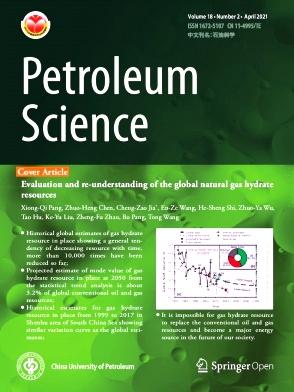基于三维岩石物理模板的致密砂岩储层属性概率估算
IF 6
1区 工程技术
Q2 ENERGY & FUELS
引用次数: 0
摘要
致密储层储层性质(如气体饱和度、孔隙度和页岩含量)的定量预测对资源评价和油井布置具有重要意义。然而,致密砂岩储层孔隙结构复杂、孔隙连通性差、流体分布不均,使得储层参数与弹性性质之间的关联更加复杂,从而给地震储层表征带来了巨大挑战。我们建立了一个部分连通的双孔隙度模型,通过考虑孔隙结构和连通性来计算弹性性质,并分析这些因素对致密砂岩储层弹性行为的影响。建模结果表明,体积模量可能受到孔隙连通系数的影响,而剪切模量则对刚性孔隙的体积分数敏感。通过将模型预测结果与干燥和饱和石英砂岩样本的声学测量结果进行比较,可以确定僵硬孔隙的体积分数和孔隙连通系数。在校准模型的基础上,我们构建了一个三维岩石物理模板,该模板考虑了储层属性对 P 波阻抗、S 波阻抗和密度的影响。该模板与贝叶斯反演理论相结合,用于量化气体饱和度、孔隙度、粘土含量及其相应的弹性参数不确定性。井录和地震数据的应用表明,我们基于三维岩石物理模板的概率反演方法在预测中国西南优质致密砂岩储层的空间分布方面表现良好。本文章由计算机程序翻译,如有差异,请以英文原文为准。
3D rock physics template-based probabilistic estimation of tight sandstone reservoir properties
Quantitative prediction of reservoir properties (e.g., gas saturation, porosity, and shale content) of tight reservoirs is of great significance for resource evaluation and well placements. However, the complex pore structures, poor pore connectivity, and uneven fluid distribution of tight sandstone reservoirs make the correlation between reservoir parameters and elastic properties more complicated and thus pose a major challenge in seismic reservoir characterization. We have developed a partially connected double porosity model to calculate elastic properties by considering the pore structure and connectivity, and to analyze these factors' influences on the elastic behaviors of tight sandstone reservoirs. The modeling results suggest that the bulk modulus is likely to be affected by the pore connectivity coefficient, while the shear modulus is sensitive to the volumetric fraction of stiff pores. By comparing the model predictions with the acoustic measurements of the dry and saturated quartz sandstone samples, the volumetric fraction of stiff pores and the pore connectivity coefficient can be determined. Based on the calibrated model, we have constructed a 3D rock physics template that accounts for the reservoir properties’ impacts on the P-wave impedance, S-wave impedance, and density. The template combined with Bayesian inverse theory is used to quantify gas saturation, porosity, clay content, and their corresponding uncertainties from elastic parameters. The application of well-log and seismic data demonstrates that our 3D rock physics template-based probabilistic inversion approach performs well in predicting the spatial distribution of high-quality tight sandstone reservoirs in southwestern China.
求助全文
通过发布文献求助,成功后即可免费获取论文全文。
去求助
来源期刊

Petroleum Science
地学-地球化学与地球物理
CiteScore
7.70
自引率
16.10%
发文量
311
审稿时长
63 days
期刊介绍:
Petroleum Science is the only English journal in China on petroleum science and technology that is intended for professionals engaged in petroleum science research and technical applications all over the world, as well as the managerial personnel of oil companies. It covers petroleum geology, petroleum geophysics, petroleum engineering, petrochemistry & chemical engineering, petroleum mechanics, and economic management. It aims to introduce the latest results in oil industry research in China, promote cooperation in petroleum science research between China and the rest of the world, and build a bridge for scientific communication between China and the world.
 求助内容:
求助内容: 应助结果提醒方式:
应助结果提醒方式:


